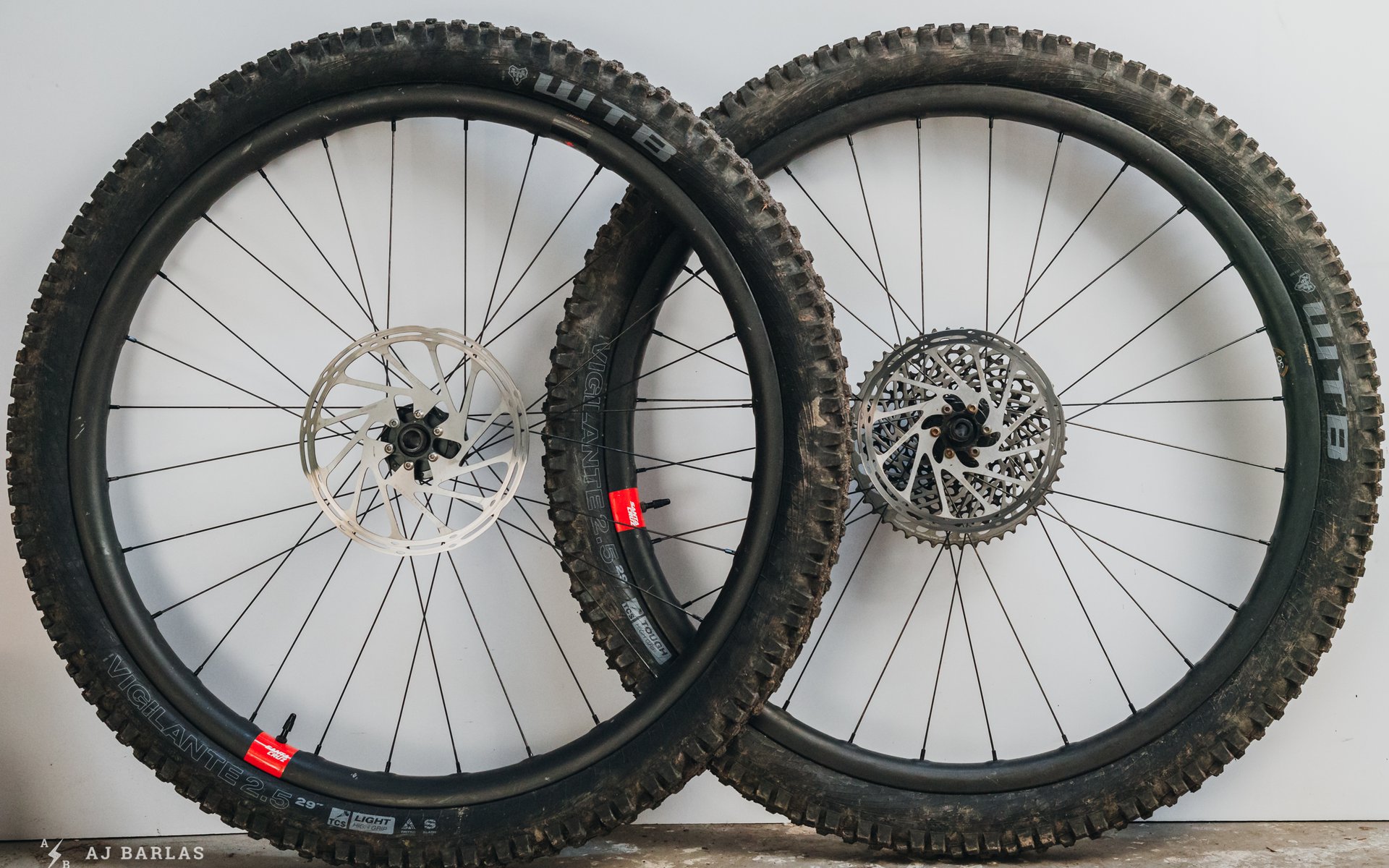
Long-Term Review
Santa Cruz Reserve 30 Carbon Wheels Reviewed
Santa Cruz Bicycles supported their June 2017 Reserve carbon wheel release with a bold claim: 'The Strongest Wheels on the Market.’ They supported the claim with a video featuring Danny MacAskill doing everything he could to destroy them. It took him a long time and a number of large hits sans tire to make it happen but he did eventually succeed.
Many of us won’t come close to the force Danny was putting into the rims. To last as long as they did with his antics is bloody impressive. Still, if a customer were to break a rim, Santa Cruz stands by a lifetime warranty with the promise of a speedy turnaround. They're off to a great start.
The Devil's in the Details
The wheels were released with 25, 27, or 30mm internal rim widths in either 27.5 or 29-inch wheel diameters. Not long ago a big daddy 37mm internal width option was also made available. Perfect for those running 2.5–3.0-inch wide tires. Santa Cruz has made simplicity a priority and there are no proprietary bits included. The wheels are built with j-bend spokes and have externally accessible nipples that feature a mechanical lock for increased durability. Both front and rear, the wheels feature 28 spokes. With carbon generally being stiffer than alloy, the lower spoke count could help balance compliance and strength.
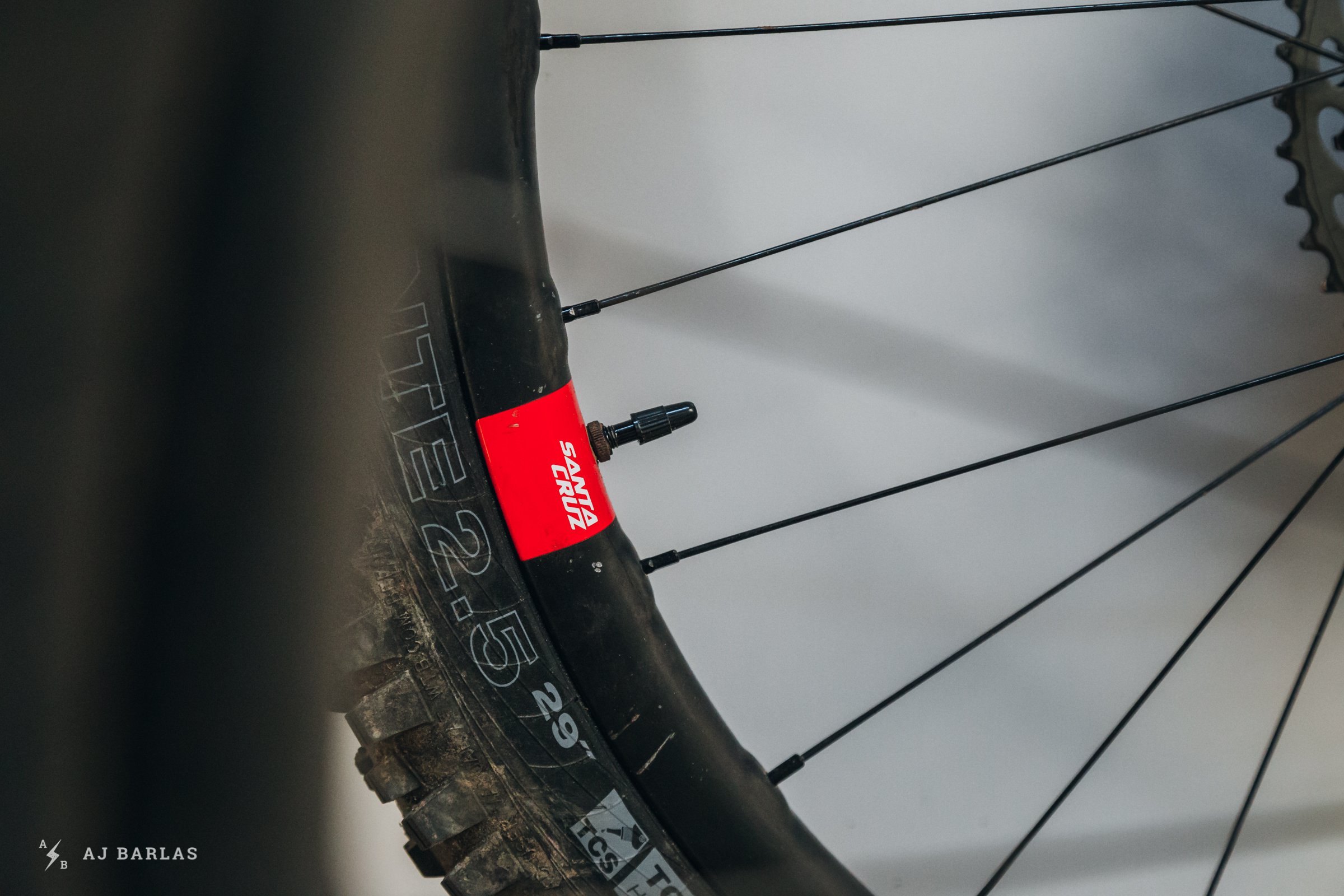
The small but effective branding doubles as an indicator for the valve. It's also really nice to see a wheel without logos occupying every inch of available surface area.
Highlights
- Wheel Diameter: 27.5 and 29 (tested)
- Internal Width: 25, 27, 30 (tested) and 37mm
- Hubs: DT350 (tested), I9 Torch or Chris King
- Asymmetric profile and angled spoke bed
- Externally reinforced spoke holes
- 28 spokes front and rear (J-bend spokes)
- Lifetime warranty
- Weight: 1,831g (claimed for the DT350 29" x 30mm tested)
- MSRP: 1,599 USD (DT350), 1,899 USD (I9 Torch), 2,199 (Chris King)
There are three hub options to choose from, starting with the more wallet-friendly DT350 tested here. At 1,599 USD they represent relatively good value, especially considering the lifetime warranty. Cheaper carbon wheels are available, but they can lack the compliance and comfort that some of the pricier options have. Weight for the 29” x 30mm option is a claimed 1,831 grams, an admirable amount. Are there lighter wheels? Yes. There are alloy wheels that at similar weights too, but carbon rims are generally undaunted by the force required to leave a significant dent in aluminum.
Santa Cruz claims to have spent significant time on the rim layup and design. The outcome is an asymmetrical rim with external spoke reinforcement and an angled spoke bed providing even tension around the nipple, all with durability as the end goal. Asymmetrical rims create more equal spoke tension, which results in a stronger wheel and the use of externally reinforced spoke holes helps ensure accurate drilling.
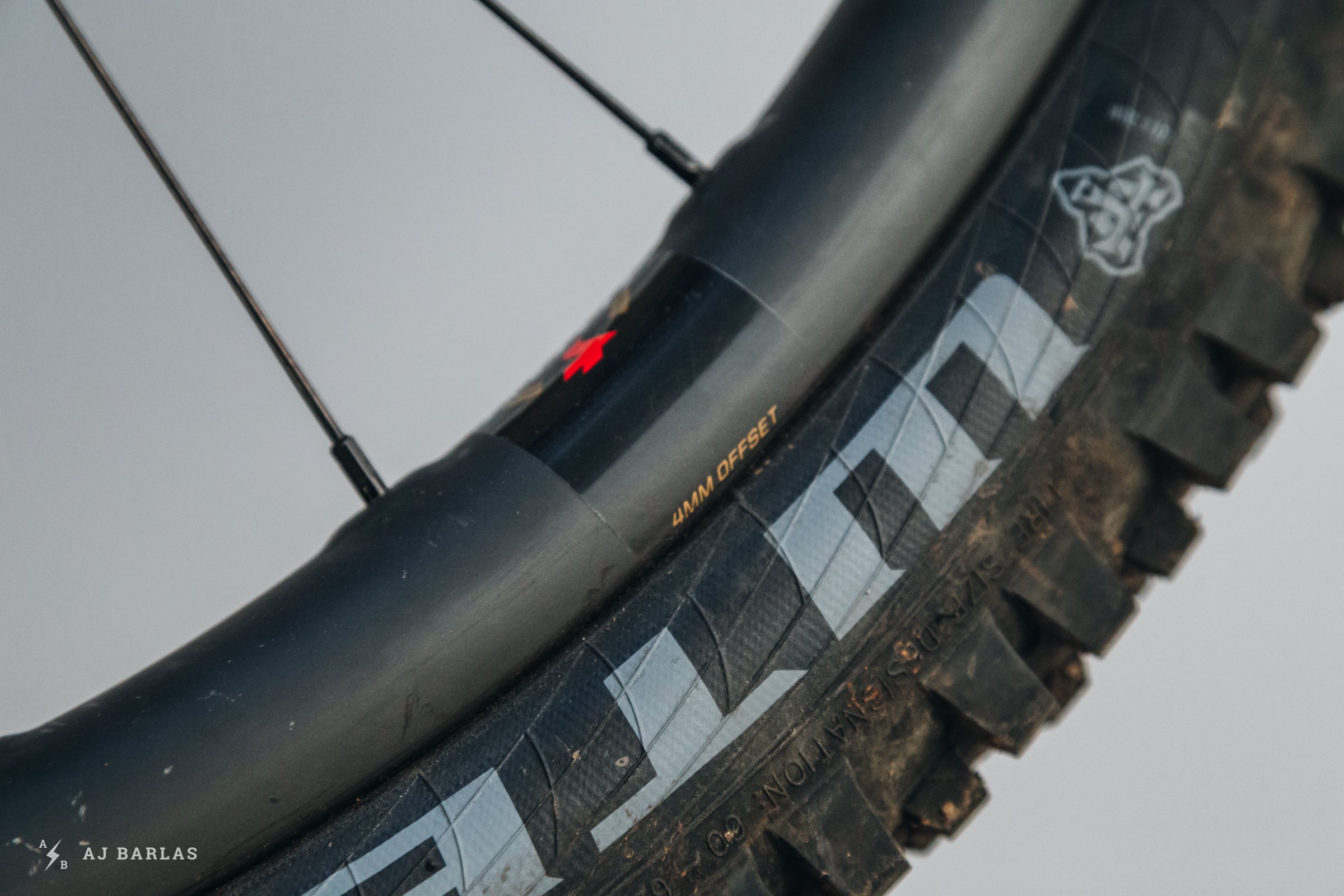
All Reserve wheels are asymmetrical and on the 29-inch Reserve 30 wheels, the spoke bed is offset 4mm. A more equal spoke tension provides a stronger wheel build.

If you want to get fancy you can go all the way to the Chris King hub build but the workhorse build is more than sufficient. The DT Swiss 350 build carries an MSRP of 1,599 USD and a (claimed) weight of 1,831g.
During testing, Santa Cruz found the spoke holes became a weak point so the external reinforcements were added for extra strength. The goal is for the nipple or j-bend spoke, both easily replaced, to break before the rim to save customers cash and hassle. SCB also wanted to address a point of failure they had noticed in competing wheels. They found many rims are tested and manufactured to absorb impacts equally across both beads. In practice carbon rims typically fail due to a hard strike to one side of the rim. It's something I’ve personally experienced a number of times and despite hitting the Reserve’s on one obstacle harder than any other, they live on.
SCB developed a layup that includes what they say is one of the thicker rim beads on the market; each bead is up to one-millimetre thicker. Adding material to the bead and using external spoke hole reinforcements allowed Santa Cruz to use less material elsewhere in the layup. This effort keeps weight in check and is said to provide a more compliant wheel.
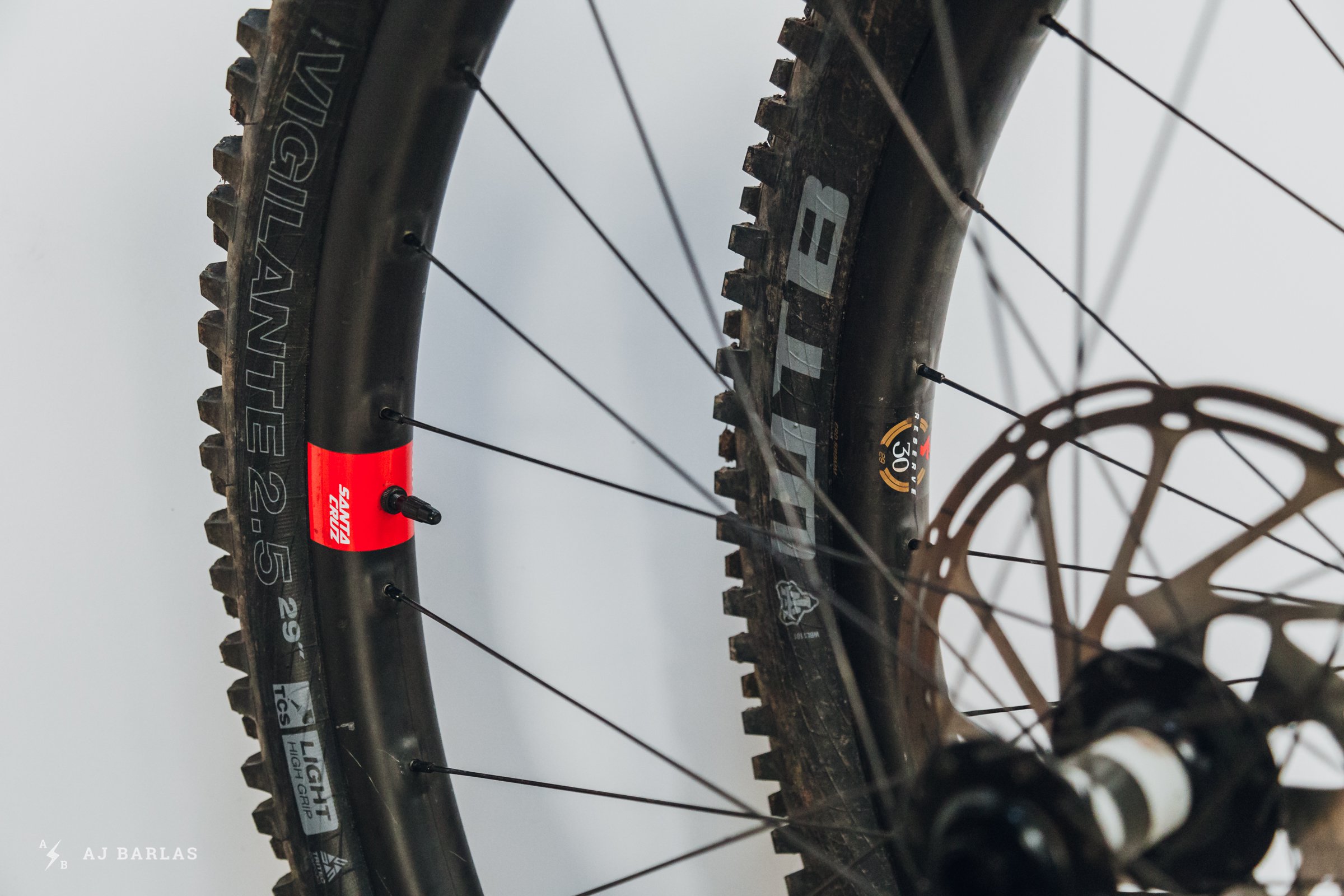
After more than 600kms, the wheels have some battle scars. Functionally they perform as they did when new and haven't needed any attention.
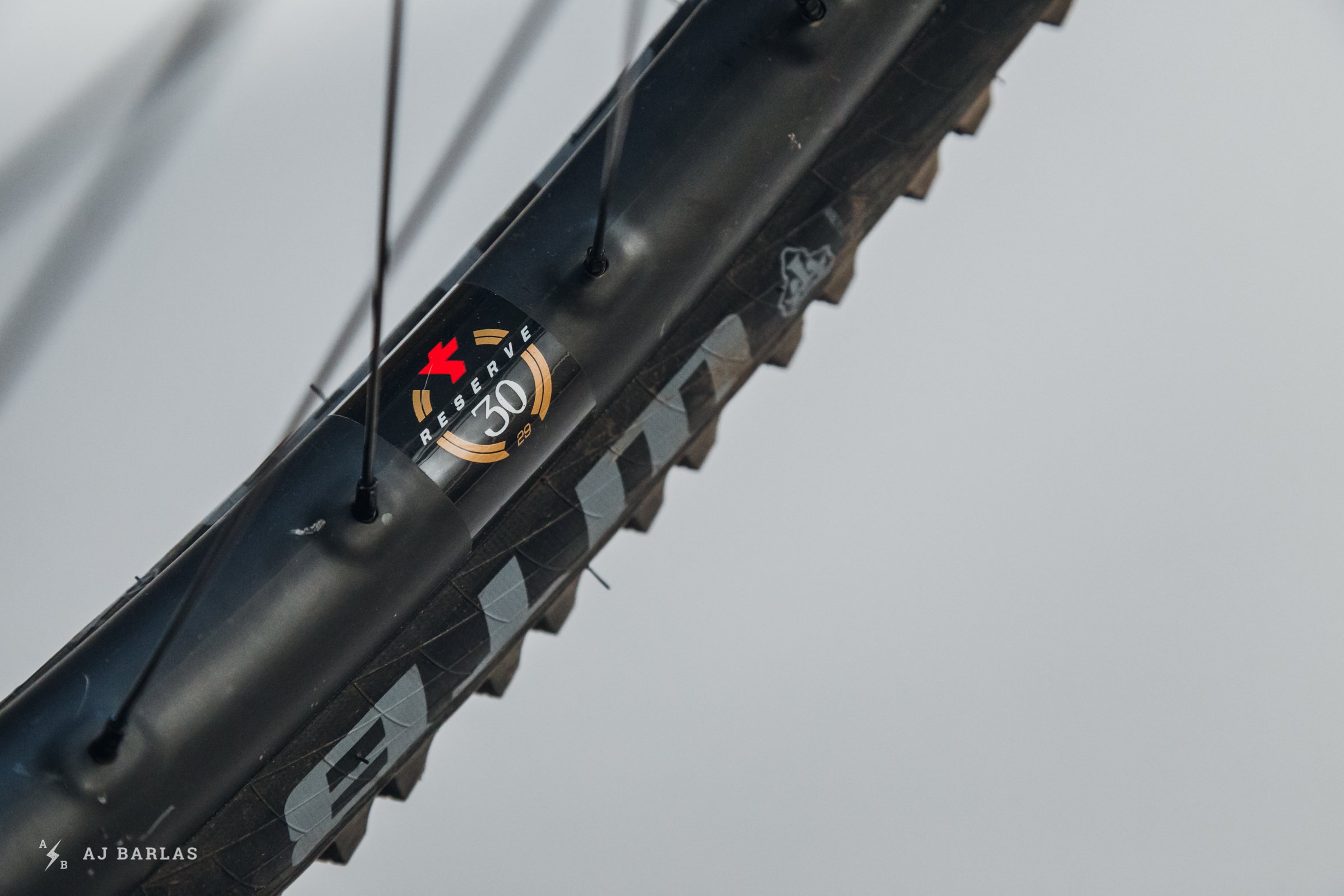
Somehow the stickers have avoided damage while the rest of the rims are chipped and scuffed…
Ride Quality
Historically, many carbon wheels provide a harsher ride than their alloy counterparts. The stiffer properties of the carbon hoops typically transfer more trail feedback to the rider. With each carbon wheel release we see improved ride quality, but have any reached the comfort of a well-built alloy wheel? The Santa Cruz Bicycles Reserve 30 carbon wheels come mighty close.
In a straight line, the Reserve 30 wheels provide a stiff feeling. Vertical forces through the wheel amount to more feedback than some of the competition. I attribute this, at least partially, to the strong spoke interface. Under acceleration, the wheel's tangential stiffness results in a spritely ride, transferring rider output efficiently to the ground. Radial stiffness also comes into play here and the Reserve 30’s are certainly strong in this aspect, as I discovered…
Later in the test period the Reserve 30 wheels were subjected to one of the worst impacts I’ve put a wheel through, which they survived without failure. It was a worse case scenario; a poorly placed rock at the bottom of a high-speed rock roll caught me by surprise. A large protruding edge from the rock sat higher than the rest of the fresh armour it was part of. As the bike compressed deep into its stroke the noise from the rear violently echoed through the woods. To my surprise, the damage was a small chip to the finishing coat of the drive side rim bead… and a ruined tire.
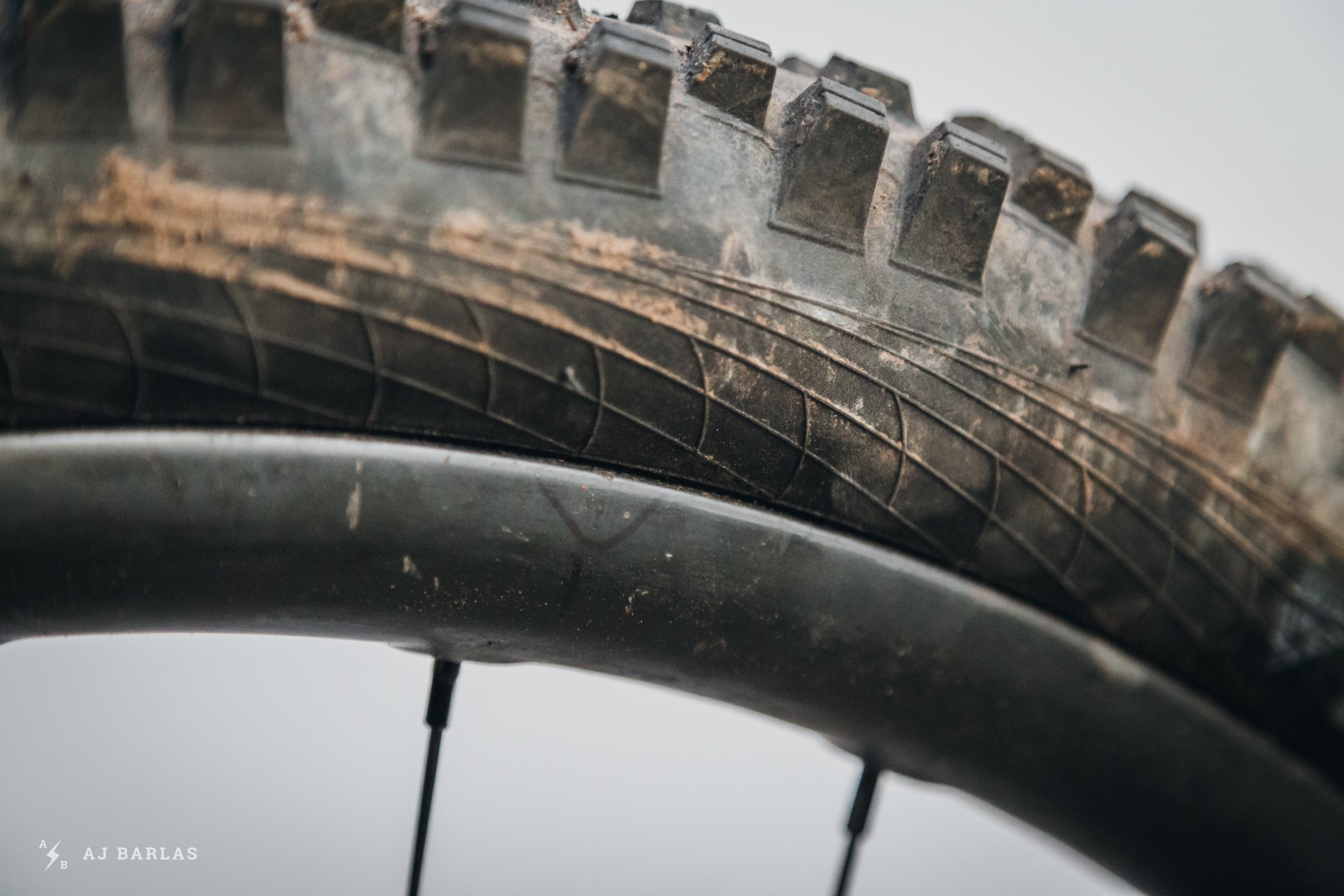
A couple of marker scribbles point out the small amount of damage after one of the largest hits I've experienced a wheel taking.
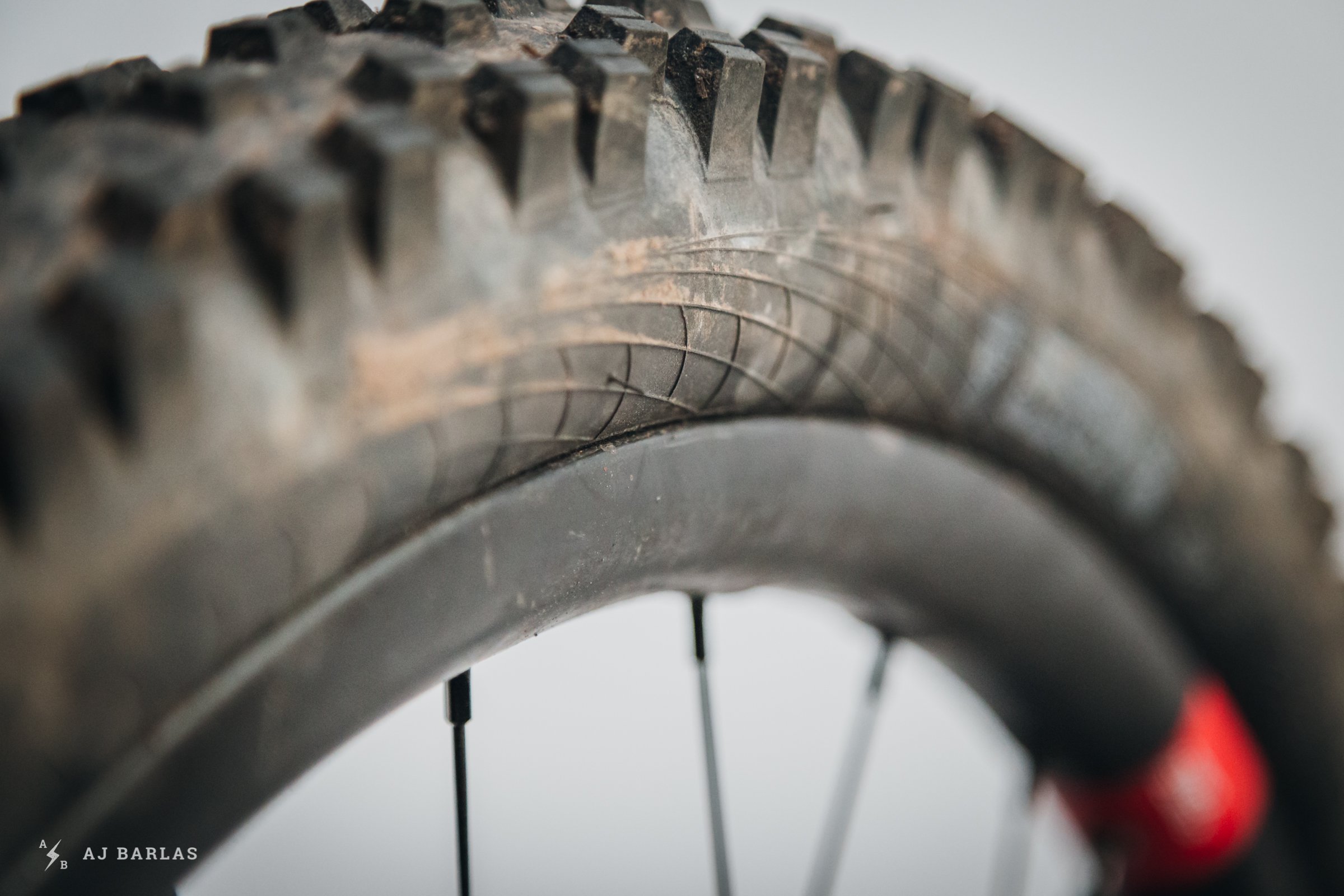
The marker makes it easy to check whether cracks are developing at the sight of the impact. A month later and nothing has changed.
Impacts of similar force and less have broken a number of my favourite carbon rims in the past. An alloy rim would have been dented badly, most likely ruining the tubeless seal beyond repair. Honestly, thoughts of testing SCB’s warranty program quickly came to mind but I was pleasantly denied. However, there is a downside to this radial stiffness. The Reserve 30’s provide more feedback than others that are more comfortable in the vertical plane, with trail chatter and square edges sending more feedback through the wheel. I also experienced more flat tires with these wheels than with any other wheel and had my first front flat in years. Coincidence? Maybe, but worth noting nonetheless. Cush Core tire inserts helped and so did running a heavier duty tire casing.
Laterally the rims are very comfortable. Deflection is minimal for a carbon wheel and while not as easy to manage as alloy wheels, they’re very good. Staying on line requires little extra assertiveness even in the greasy wet conditions experienced lately. Loading up hard into corners produces the sort of propulsion that I’m yet to experience on an alloy wheel and deep compressions while riding ragged are quite manageable thanks to the wheels overall ride quality.

Externally reinforced spoke holes have been used to create a stiffer wheel. It's especially noticeable under tangential and radial loads with quick acceleration and their ability to remain solid after large impacts.
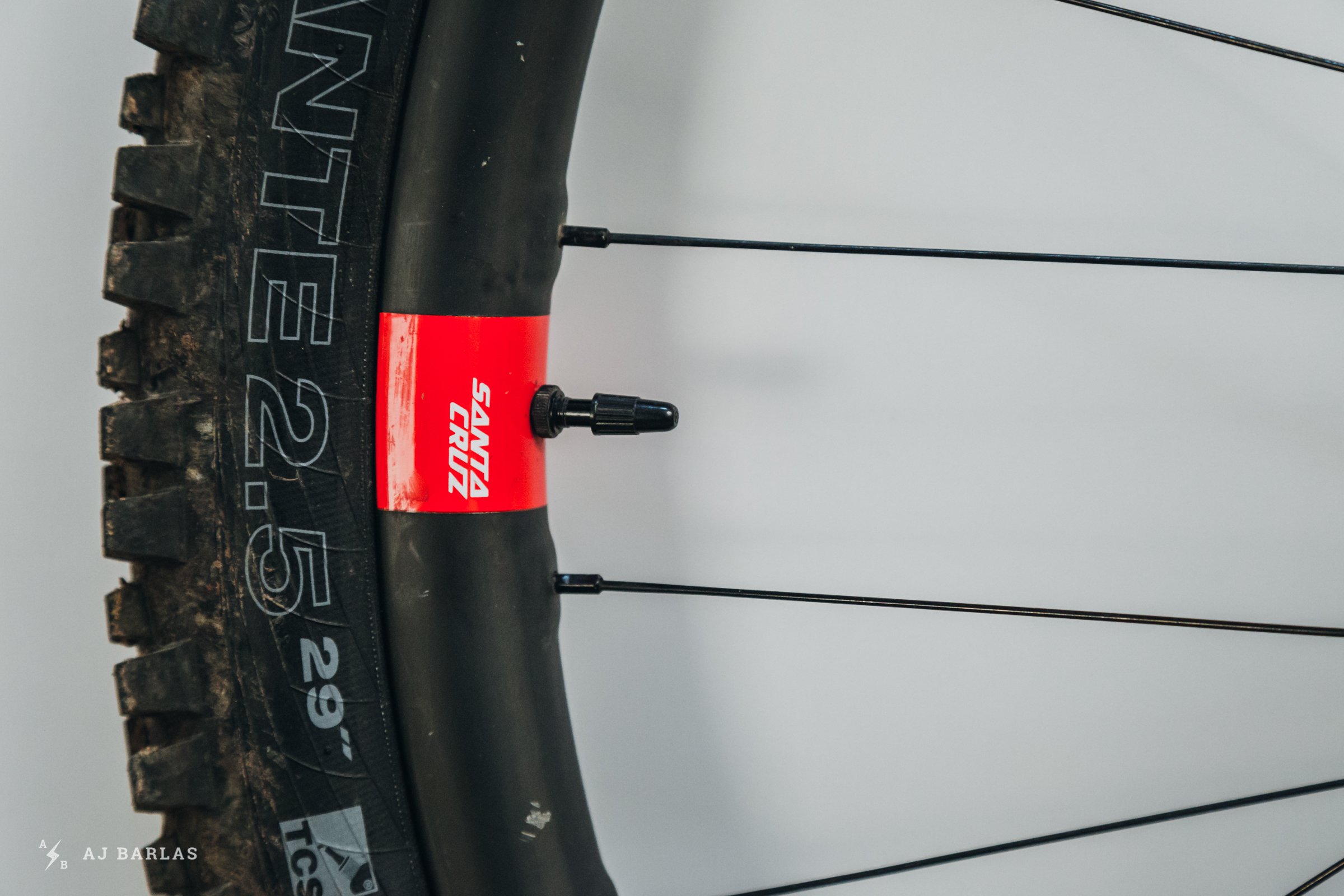
Laterally the wheels are very comfortable. They still offer the excellent 'spring' out of corners that carbon has become known for, but provide minimal deflection from obstacles in the trail.
Regardless of the heavy hit, neither wheel has required the attention of a spoke key. The wheels have been wrapped with a number of different tires over the more than 600kms of riding they’ve seen. Aside from some tires being more of a challenge than others to seat, there have been no problems to speak of.
I don’t envy brands trying to make the perfect carbon wheel; it has to be an incredibly difficult task. While an alloy wheel will provide a more comfortable trail feel than the Reserve 30’s, especially for the discerning lightweight rider, these score points as one of the best carbon wheels available. When considering trade-offs, the strength to comfort ratio of the Reserves strikes an excellent balance, unmatched by the competition. Add that they’re cleverly built with easily accessible replacement parts and include a lifetime warranty, and you really can’t go wrong.
Head to the Santa Cruz Bicycles website for more on the Reserve wheel range.







Comments
legbacon
5 years, 6 months ago
I would love to see these compared to We Are One wheels.
Reply
Nouseforaname
5 years, 6 months ago
WR1/DT350 = $1597 CAD
SCB/DT350 = $1599 USD.
I know where my money would go.
Reply
Perry Schebel
5 years, 6 months ago
i honestly don't know why one would buy anything else. i don't even have these wheels, and i'm a fanboy.
Reply
Nouseforaname
5 years, 6 months ago
It's the attitude of WR1 that is the game changer - North American (cause i'd be interested to see a comparable US made product) made AND willing to stand behind the product. Two things that aren't available at that price point from anyone else.
There's well priced (not cheap!) wheels, and there's NA made wheels and there's wheels with back up, but no one else has got all three. I wonder why? Let's face it, a small start up in Kamloops shouldn't be this far ahead of the competition.
Reply
rhw
5 years, 6 months ago
WR1/DT350 = $1597 CAD
SCB/DT350 = $1599 USD.
FlowMk3/DT350 = ~600-700 CAD?
I know where my money would go ;-)
Reply
Nouseforaname
5 years, 6 months ago
$700 - (I see them around $700 USD) seems on the cheap side for that, but even then - I wreck 1-2 rims per year @ $100 per plus the build. Not going to take a long time for me to have covered the cost of the WR1 wheels.
Reply
rhw
5 years, 6 months ago
I did write "my money" ;-)
Reply
Jan
5 years, 6 months ago
It was the Santa Cruz video from a few years ago showcasing carbon vs aluminum frame failure thresholds that ultimately persuaded my faith in carbon frames. After SC released their Reserve wheel set, I was sure I would be riding them within the year.
Enter WR1 with a lifetime warranty, my favorite hubs, and a lower price point...
Many thanks to Santa Cruz for proliferating the technology... but all the high fives to Dustin for being rad and bringing that to the Great White North.
Reply
JT
5 years, 6 months ago
More for curiosity as these don't open my wallet, but do you know what spoke tension the wheels are running? In my experience, low spoke count wheels always need to run higher tension as there are fewer spokes sharing the load and importantly fewer crossing spokes (2x as opposed to 3x). This translates to a harsher ride, since the spokes aren't able to stretch/behave like a spring as well as they do at lower tensions. I've built a few carbon wheels for customers, and the rim stiffness is evident right from when you lace them up. Basically, I'm wondering what would happen to the ride quality if the tension was dropped a couple kg's.
Reply
AJ Barlas
5 years, 6 months ago
Sorry JT, I don’t. It’s a very good point though and I will try to check this in future.
Regarding slackening off the tension… I used to think similar but after chatting with a couple of product managers and engineers, I’ve been convinced that loosening spokes has no effect. Unless going far enough that it would no longer be wise to ride the wheels. This seems to be especially the case where carbon is concerned.
Reply
JT
5 years, 6 months ago
Interesting response from the engineers. Given that tensile strengths of straight gauge, double butted, and bladed spokes differ wildly, I'd expect to see an effect. Guess I need to read Jobst Brandt's book again to better form my thinking.
Reply
Perry Schebel
5 years, 6 months ago
more, or fatter spokes will increase wheel stiffness, but varying spoke tension (at least within a functional rage, ie, not flopping in the breeze) will not make an appreciable difference. at least, sayeth the wheel gurus.
Reply
JT
5 years, 6 months ago
Some maybe, but not all. The amount of 'spinging' is referenced in The Art of Wheel Building, but I oughta stop now before I fully geek out. Even more than admitting I'm going to re-read Jobst! :D
Reply
Alex D
5 years, 6 months ago
Strength and stiffness are not the same. Stiffness is the extent of elastic deformation for a given force. Strength is the force required for permanent deformation, which, for spokes in a given configuration, depends on the material and how it was worked. Stiffness only depends on the material and cross-sectional area. So, for example, butting a straight-gauge spoke to reduce the middle diameter will reduce stiffness and (potentially) increase strength.
Tension doesn't affect stiffness because it doesn't change the Young's Modulus of the material. Whether a material starts in tension or not, it'll stretch the same distance in response to a force (within its zone of elastic deformation). More tension does increase load capacity and reduce spoke fatigue, however.
Since we're talking about ride quality: from a (simplified) physics perspective, a bike is just a spring series. Tires, rims, spokes, suspension, frame, post, and saddle all have effective spring rates. The higher the spring rate of one component relative to the others, the less relative contribution it has to ride quality. If you apply a force to something stiff connected to something flexible, the flexible thing will yield a lot and the stiff thing won't yield much at all.
In this system, spokes are *really* stiff. So are carbon rims. Frames and posts, a little less. Tires, saddles, and suspension are much, much less stiff, often an order of magnitude or more. As a result, these latter three absolutely dominate ride quality perception. Spoke counts, lacing pattern, materials, and type have a substantial effect on lateral stiffness, but on the vertical? The rest of the system obscures their contribution.
Reply
Cam McRae
5 years, 6 months ago
Just what I was thinking Alex! Lol. Excellent post.
So nice to have such productive comments.
Reply
Alex D
5 years, 6 months ago
Thanks. I don't want to push the physics model too hard, though. The 'as applied' gets a little tricky with mountain bikes. Just riffing, we need to account for:
Suspension:
* Static friction ("stiction")
* Dynamic spring rate (progressive = increasing spring rate)
* Compression damping (speed-sensitive dynamic friction)
* Chain interactions (anti-squat)
Tires:
* Pressure
* Sidewall stiffness (dynamic friction)
* Dynamic spring rate (from inserts and natural progressiveness)
Globally:
* Travel limits (suspension > tires > frame > saddle > spokes)
* Construction differences (e.g., intentionally flexible rim sidewalls, frame designs, etc.)
* Overload behavior (e.g., running out of spoke tension)
* Co-dependencies (e.g., a stiff rim distributes load to more spokes)
* Rider position (weight distribution, loaded contact points?)
* Bike orientation (leaned? on the back wheel?)
It's a very dynamic system. Spokes are so far in one direction that I'm confident they almost never affect ride quality, but rims? Most of the time (perhaps all of the time if you're a light and cautious rider on a full-squish), no, but some people will find a spring equilibrium radically different from the bike at rest. That may well highlight otherwise imperceptible differences.
[user profile deleted]
5 years, 6 months ago
This comment has been removed.
awesterner
5 years, 6 months ago
But you won't get that answer out of a Product manager :-)
Applesauce
5 years, 6 months ago
Lower spoke counts don't require a lower number of crosses, assuming fairly normal hub and rim dimensions, until you get to 24h wheels. Reserves are 3x, for instance - and the vast majority of OE wheels on SC for years have been 28h and 3x (I've been selling and servicing SCs for a decade). I have even built a few 24h wheels with 3x, though I'm straining to remember what...I think DA 9k hubs will permit 24h 3x on the driveside rear, assuming a fairly shallow rim.
The long and short of it is, 28h does not automatically require 2x, and in fact will almost always support 3x, especially on a 29er wheel.
Reply
Alex D
5 years, 6 months ago
This comment has been removed.
earle.b
5 years, 6 months ago
" Asymmetrical rims create more equal spoke tension, which results in a stronger wheel and the use of externally reinforced spoke holes helps ensure accurate drilling."
Say what? Accuracy of drilling a hole would be due to their equipment and jigs, not due to extra material around where you plan to drill. Just saying.
"SCB developed a layup that includes what they say is one of the thicker rim beads on the market; each bead is up to one-millimetre thicker. "
Why not measure it? And compare it to every other rim you can get your hands on? Didn't the Crankbrothers wheels just claim to be the widest bead on the market? Would be nice to see reviews actually do some digging into the claims thrown around.
Reply
AJ Barlas
5 years, 6 months ago
When I have the tires off next I'll measure away, Brian. Until then I can confirm that in my experience the bead is stronger than past carbon rims I've ridden.
To your first comment: yes, accurate jigs etc. are important, absolutely no doubt. But how do you ensure the reinforcement is accurately placed to begin with? I'm not the most knowledgeable of the carbon layup process (I don't imagine anyone who isn't actually working with it is) but I imagine the external placement grants confidence that the reinforced sections are exactly where they need to be.
From SCB: "We're far from the first company to reinforce high-stress areas with more material, but they're visible to ensure that the spoke hole drilling matches the reinforcement."
Reply
Jason West
5 years, 6 months ago
Didn't Greg Minnaar blow the shit out of one of these wheels?
Reply
sansarret
5 years, 6 months ago
This comment has been removed.
Please log in to leave a comment.